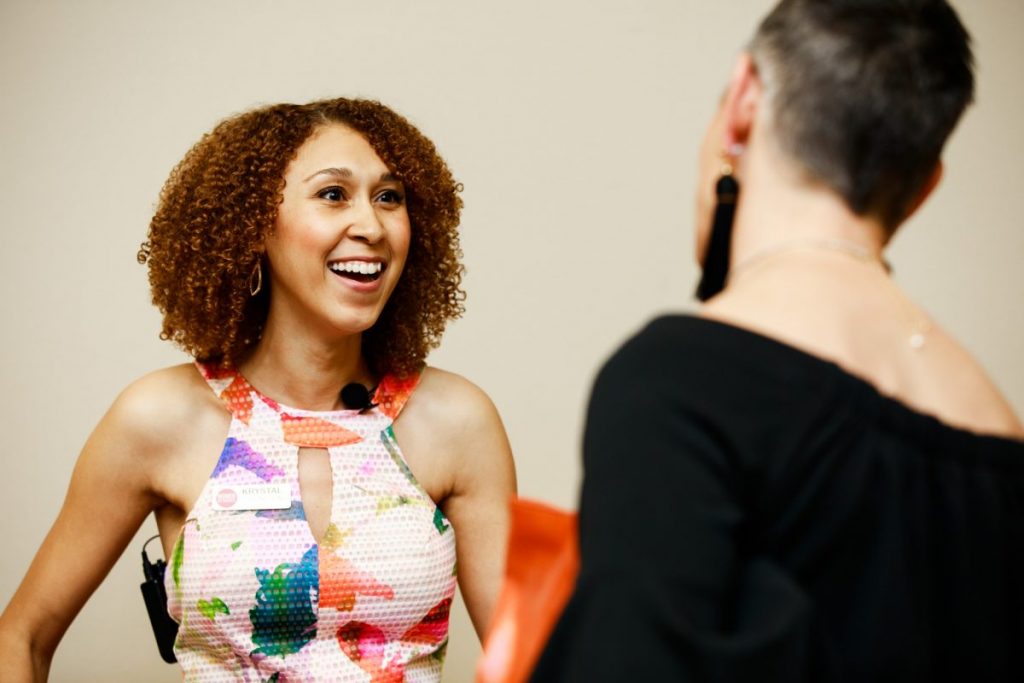
Reopening a business of any size amid a global pandemic is a fraught experience for any owner — both in terms of how to do so, and in terms of whether or not to do so at all.
We spoke with three women business owners who are presently navigating three very different reopening processes, to spotlight the myriad difficulties, the mental juggling acts, and the ongoing uncertainties surrounding getting (safely) back to the grind.
Though their individual stories vary, one thing is for clear: “normal” is still a ways away. But when it’s due to ensuring the safety of others, that’s okay.
Krystal’s Story: Not (Yet) Open For In-Person Events
Networking group Women of Denver isn’t back to operating in-person just yet — much to the impatience of its membership.
But Krystal Covington, the woman who runs this hundreds-strong collaborative of professional women, isn’t taking any chances. “There’s still a deep fear of someone getting sick on my watch and having a tragic outcome, or putting my team at risk — all of whom have children,” she says.
The organization’s events range in size, but can see upwards of 200 attendees at a time, Covington says. But even the prospect of smaller-scale events — think, 15 or 20 participants — “feels overwhelming to me, as there’s still a potential for anyone to be exposed.” Plus, she finds social distancing to be “contradictory to the purpose of networking” as it eliminates everything from handshakes to the prospect of gathering in smaller groups to collaborate.
Still, members have been anxious to get back together since last spring. Zoom fatigue — we all know it by now — hit Women of Denver hard, Covington recalls, and she was fielding requests for in-person meetups not long after the coronavirus crisis began in earnest. At first, she wanted to wait until mask and social distancing requirements were dropped before even considering in-person events.
Now, in Denver, those guidelines have been removed. Yet for the time being, Covington is still holding back. She wants to see what happens regarding transmission rates before jumping back into the swing of things. And there’s also the matter of legal liability, she adds. “I know treatment for this virus is very expensive, and want to be careful of being certain how to handle any liability prior to launching live meetings again.”
Navigating the group’s frustrations with remaining virtual has been tough, but Covington’s reply to the notion of risking anyone’s safety at present is a simple one: “It’s not worth it.”
Pam’s Story: Fully Reopened
Last summer, Pam Decharo was ready to reopen Hair International, her Palo Alto, California, hair salon. On July 13, 2020, the big day arrived. And then, on July 14, she was forced to shut down once more due to another surge in Covid-19 cases.
She ultimately reopened for good on Jan. 27, after a second false start last August that ended last December. But the roller coaster nature of the process wore on her — she even lost 15 pounds due to stress, she says.
Decharo also lost a significant amount of money, sinking a significant portion of her retirement fund into refurbishing the salon’s air filtration system and buying PPE for her staff at the height of hoarding and price-gouging in the U.S. And even still, she couldn’t bring everyone back due to social distancing guidelines. Before the pandemic, she had 55 employees — now, she has 22.
Then there was the taxing process of staying in touch with customers. “Everyone was scared to death. They didn’t know what was going to happen. There was no talk of vaccines — everyone was terrifying.” Her stylists — those she could bring back on board, and those she could not — were also struggling mentally and emotionally. All she could do, she recalls, was tell them to stay hopeful, to hang on, to keep going. “When I think about it now, I almost get physically upset at how frightening it was,” Decharo says.
Getting back to “normal” is still an ongoing process — she admits they’ve had some “bleak weeks,” despite the “first adopters who fearlessly ran out to get that first haircut.” But as vaccines continue to roll out, more people are returning, she says. As of April, her entire staff was fully protected, too.
And, she adds with pride, she was able to keep one significant promise she made to herself ahead of that very first reopening day — not one employee has gotten Covid-19.
Rowyn’s Story: She’s Back — But Not
It’s one thing to go back to the office. It’s another to greet the general public face-to-face mid-pandemic — especially when you’re non-essential.
This is the quandary that Rowyn Golde, co-owner of an unusual business, Team Manticore, found herself grappling with when it came time to reopen. Her company makes monster-themed apparel and accessories, much of which is sold at conferences held around the world.
At first, of course, that was impossible due to travel restrictions and guidelines against large gatherings. So she pulled a pandemic pivot and significantly stepped up her business’ e-commerce game. Golde, who runs the two-person venture with partner Robert Silver, gave herself a crash course in online marketing, joining Facebook groups and taking web workshops to figure out the world of effective virtual ad placement.
It helped fill the gap, but “I know now that we still do best at those shows, so we need to get back to conventions, fairs, and so on,” she says. “It’s pretty scary though, given everything that’s happened, and continues to happen.” And that fear permeates the entire going-back experience, she says. She purchased themed PPE, but admits such steps feel more “dire” than kitschy. She’s scheduled to attend three conventions now — two in November, and one next year — but other events that were once a part of her annual rotation no longer exist.
And, she adds, there’s no way to ensure the vaccination status of customers. So at present, her business model is a patchwork of tentatively seeking out the in-person sales tactics that worked best “before,” and the online sales that are getting them by now.
“We’ll see how it goes,” she says. “It feels like a balancing act.”




